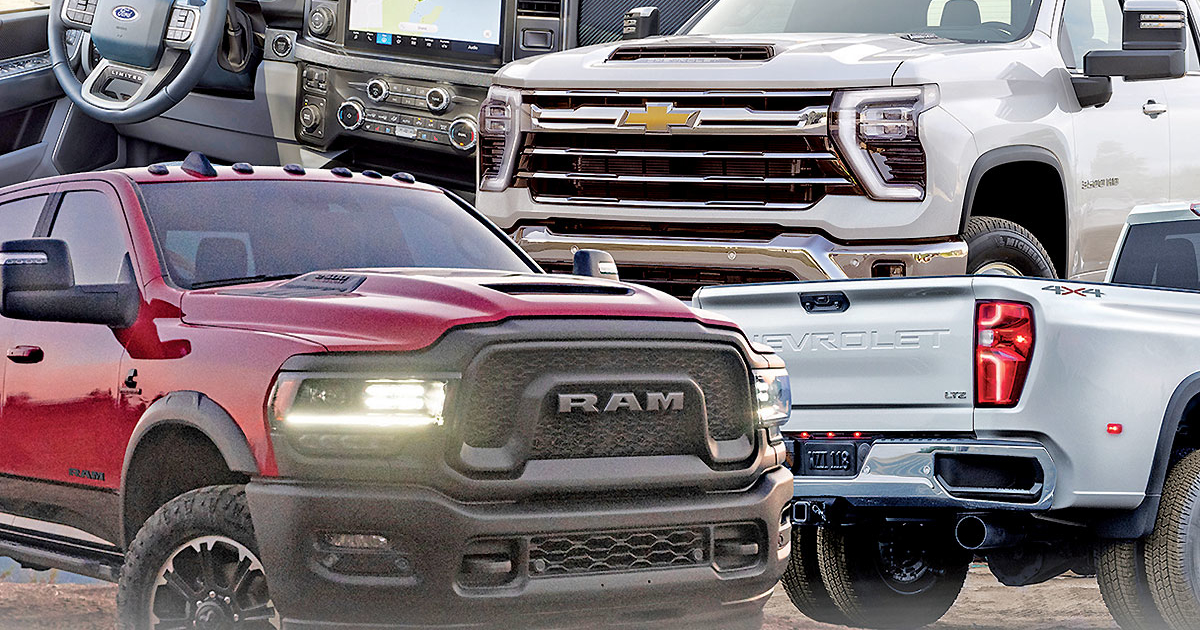
LOUISVILLE, Ky. — The Detroit 3 are pushing rapidly toward an electric future for their light-duty pickups, but it’s a different story for the biggest trucks in their lineups.
Heavy-duty pickups are among the few vehicles still seeing big investments toward development of more powerful gasoline and diesel engines. Although the segment isn’t huge, the money at stake is. Ford Motor Co. says it gets more revenue from Super Duty sales alone than Southwest Airlines, Marriott International and many other Fortune 500 companies generate.
These big trucks are high-margin profit machines that will be key to funding automakers’ electric ambitions, but executives say they’ll likely be among the last vehicles in the industry to get battery power — if they ever do.
“If you’re pulling 10,000 pounds, an electric truck is not the right solution. And 95 percent of our customers tow more than 10,000 pounds,” Ford Motor Co. CEO Jim Farley told media at the Churchill Downs horse track, where it revealed a redesigned Super Duty line. “This is a really important segment for our country and it will probably go hydrogen fuel cell before it goes pure electric.”
In 2023, Ford is rolling out new gasoline and diesel engines on the 2023 Super Duty, General Motors is giving the 2024 Chevrolet Silverado HD a stronger diesel engine and the 2023 Ram HD lineup is gaining a Rebel performance variant.
Even as California plans to ban gasoline-powered vehicle sales after 2035, it’s making exceptions for heavy-duty pickups, Farley noted, giving the company confidence that sales of the trucks won’t be limited in the future.
Todd Eckert, Ford’s truck group marketing manager, told Automotive News that buyers of heavy-duty trucks — commonly used in mining, construction and utility work or as emergency response vehicles — haven’t shown much interest in EVs. Rather, they’re focused on what can best get the job done.
“We haven’t seen a huge clamoring,” Eckert said. “It’s about productivity, capability and efficiency. Right now, gas and diesel really serve those needs.”
The 2023 Super Duty lineup, expected to go on sale early next year, will get an embedded 5G modem with over-the-air update compatibility, an on-board generator and an upfit integration system for fleet buyers.
Ford also is adding driver-assist technology for towing and hauling, as well as features such as a new backup camera to be used when a tailgate is down.
A standard 6.8-liter V-8 engine replaces the current 6.2-liter V-8, and a new high-output 6.7-liter PowerStroke V-8 diesel will be offered. Those will join the carryover 7.3-liter V-8 and 6.7-liter PowerStroke V-8 diesel to give the trucks what Ford says will be best-in-class towing, payload, torque and horsepower figures.
Ford last week said it will invest $700 million and add 500 jobs at its Kentucky Truck Plant to support Super Duty production. Elsewhere in the state, though, Ford is investing heavily in EVs. The automaker, along with battery partner SK Innovation, is pouring $5.8 billion into a battery manufacturing complex in rural Glendale that will create about 5,000 jobs.
Farley said the investments are an example of Ford’s two-pronged approach of transitioning to EVs while investing in targeted segments keeping internal combustion engines. “This is the real foundation of the future of the company,” he said.
Chevy says it will continue to spend money on internal combustion engine vehicles where it sees demand.
“Our intent is to play in both sides of the business as long as we need to, giving customers choice,” Scott Bell, vice president of Chevrolet, said during a media briefing last week. “We’ll continue to have the broadest portfolio going across both forms of propulsion.”
The brand is updating its line of gasoline-powered heavy-duty pickups with a standard 10-speed transmission, a more powerful diesel engine, a plusher interior and new trailering technologies. It’s also adding an off-road ZR2 trim.
That variant will compete against the new Ram HD Rebel, which debuted last week at the State Fair of Texas and comes with either a 6.4-liter Hemi V-8 or a 6.7-liter Cummins Turbo Diesel.
While Ford boasts about dominating heavy-duty sales to commercial buyers, Chevy says it has the highest retail market share in the segment.
Heavy-duty models accounted for about one-third of U.S. Silverado sales in the first half of this year. Silverado HD sales rose 15 percent from January through June, compared with an 18 percent drop for the 1500. Ford and Ram don’t break out light-duty and heavy-duty sales separately.
“We see this segment as maybe one of the last to hang onto ICE,” Bell said. “We’re continuing to see opportunity here and making big bets on this franchise for the future.”
Nick Bunkley contributed to this report.